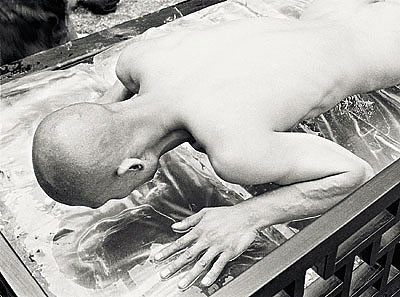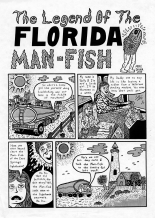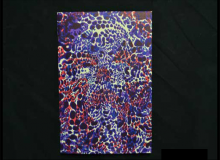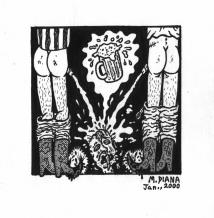| Revista Umělec 2004/4 >> Chinese Art: Persistence of Globalism | Lista de todas las ediciones | ||||||||||||
|
|||||||||||||
Chinese Art: Persistence of GlobalismRevista Umělec 2004/401.04.2004 Leng Lin | China | en cs |
|||||||||||||
|
A new dynamic in contemporary art over the past decade has emerged with a pivotal role played by biennales and triennales. Artists of diverse cultural origins are seen trying various experiments and expressions that reflect their own individual vision of the future. In such an environment, where everyone is trying to enter the international art arena, never before have so many local artists had so many opportunities as today. Even when appearing with collective identities, representing nations or regions, individual artists are trying to cut loose from any such identity. In most contemporary Asian art, artists as individuals are trying to locate themselves, identifying with national or regional cultural attributes. However, in that very pursuit of identities and expression of their life, Asian artists appear extremely hesitant and ambiguous; it is there that contemporary Asian art becomes diverse, elusive and problematic.
Artists in Place Due to irreversible historical circumstances, contemporary Asian art as a whole is entering a stage in which, after previous resorts to modernity under the rubrik of nationality, have fallen apart, it is involved in processes of globalization in many ways. In different areas of Asia, in the 1990s, it is a common phenomenon that artists, critics and art agents have become distanced from each other, each trying to find novel ways to meet in a new cycle of life. Asian artists have entered international stream of exhibitions. Since the 1990s, Asian art has been engaged with the process of globalization, crossing international borders at great speed. Such a process has resulted in a subtle but substantial shift in artists’ organic relationships with regional realities. The artists' historical roles and responsibilities in regions have been redefined, and are increasingly associated with globalization through which the discovery and confirmation of self identity is positioned within the space created by the globalization tendencies of the 1990s. In the works of art during this period we can clearly identify many self (or self-culture) referents that serve not merely as an instinctive reaction to the alienation resulting from globalization, but also represent a conscious effort to acquire subjectivity by re-shaping identity in the context of globalization. That is not all. The very concept of region is undergoing a transformation. Whereas the word's meaning had been closed, defined by clear-cut national borders and associated with the historical origin and development of a nation, it is now transformed to a more open, synchronized and spatial concept: place. In the process of such a transformation, artists and curators, as individuals, are gradually giving up any historical attachment to region and defering to responsibilities associated with the development of cross-border, cross-national and cross-cultural activities. In fact, they have increasingy become the organizers and creators of such crossing activities. Artists and curators have sewn together a network enabling various interactions to take place among people from diverse cultural backgrounds. This combining of cultures has become typical of place. Through this way of combination, place is enabled to manifest a global identity. In turn, with this identity being confirmed, place has become the embodiment of globalization, where its energy and appeal take place This has strongly captured the attention of Asian artists who have, through that, become global artists. This is not to say that these are independent artists. The future direction of artists is determined by whether they create on the basis of their backgrounds, or if they make use of their cultural original simply as a basis to confirm identity. Over the past decade or so, essential changes have taken place with artists’ working conditions. Chinese artists, for example, can either live in China or abroad; they can cater to both the needs of foreign and domestic audiences. To some extent, today’s Chinese artists enjoy much more freedom than before. However, in reality the professional aspect of artists takes precedent over the artist‘s role as social spokesperson. Sometimes, even if they do act as social spokesperson, it is as part of their professional presentation. Being an artist is just a career; if there is a need, the artist goes to work. The cultural background of an artist has become an instrument of professional strength. An independent artist is akin to that of a self-employed worker. In appearance, artists have freedom to live and work but they are constantly tormented by the anxiety of always needing new customers. Contemporary Chinese artists who have emigrated tend to contribute to the art scenes of their adoptive countries. Fully conscious of the strategic importance of such acts of participation, they deliberately participate in the visual construction of international metropolises. This is the case with Chinese artist-immigrants including Cai Guiqiang, Xu Bing, Gu Wenda and Huang Yongping. These artists‘ works often, if not always, feature certain magnified cultural signs that are hard to traso, and resemble a signal board, creating an atmosphere that a Chinese viewer comprehends, but has trouble identifying with. The artist consciously takes part in this strategy. That increasingly becomes their instincts, their foundation of daily life and experiences. Meanwhile, most local artists are unknowingly shaping global culture. But the strategy they have taken reveals a degree of hesitancy and an awareness of a kind of incompleteness. That sense of incompleteness is characterized by artists working locally like Song Dong and Feng Mengbo, in whose work there is always a conflict between self-awareness and cultural signs and symbols; the signs and symbols have not become the artists’ self-awareness completely. In their works, self image often appears, and self image therein materializes culture. In contrast, in the works of emigrated Chinese artists, culture materializes the self image of the artists. Asia in Transition Since the 1990s, the global economy has undergone dramatic changes. Driven by the power of capital, all societies have to keep up with the movement of money. The flow of capital has formed two modes: “fusion-adoption” and “containing-integration.’’ The change has not only brought about a social discussion about internal values but also highlighted the external, political issue of whom to serve. In fact, the process of “fusion—adoption’’ began a century ago in Asia when the concept of nation took hold in China and neighboring countries. But these countries did not change so much internally in nature. But over the past ten more years, old-fashioned ideologies have lost ground, while a new social ideology has yet to be established effectively. Such is the case in China. The social foundation was liberated the basic material desires of the individual in the “reforms” and ‘opening up‘ movements. The external, powerful capital is molding its own ideology amongst its selection of combination with an evasion from the material individual. The concept of China becomes an unprecedented one. Just to give some examples. There exists an exported China and one that is not; there is one China that is packaged and one that refuses to be packaged; and there is a China of the individual artist and one of small groups of artists. It has become impossible for the reproduction of internal culture to continue and culture is put into a new system of global cultural reproduction. The making of “contemporary Chinese Art” is actually carried out within this new system. Therefore, it becomes very difficult to define “contemporary Chinese art” under the structure of local culture. Instead, it only can find its place somewhere in between “Western contemporary art of China’’ and “Chinese contemporary art of the West.” This uncertainty makes it hard for the Chinese artist to have any sense of belonging. Therefore, seeking self culture identity, expressing this existential uncertainty and life experiences, have become unkowingly a choice for many Chinese artists. Evidence of this is in the works of many local Chinese artists and those who have emigrated. By this choice, they build up a sense of belonging for themselves in global culture. This is a special type of individual defined by the characteristics of “contemporary Chinese art.” However, the endless expansion of the individual’s material desire has flooded some specific individuals with self-indulgence. In this respect, Asia has become an obstacle-free channel and a source of artistic imagination for Asian artists to ensure their status quo. One viewpoint shared by critics, from both inside and outside Asia, is that the continent is full of creative potential. That expectation leads one to imagine powerful creativity in Asia. But when examined closer, the creative power of the Asian artist lies not in the pursuit of any ideal or goal but the artist‘s means, strategy and methods. This may have been caused by the constant existential pressure and day-to-day fight against all kinds of difficulties. As Asian contemporary art has been in the “fusion-adoption’’ stage, strategy has become the key to survival in the international art arena. What has Been Done in Asia and about Asia? In many places, biennales, triennales are developing very fast. It seems as if the staging of such festivals helps to discard the burdens and shadows of historical happenstance. For example, the Shanghai Biennale seeks to change the “containing-integration“/”fusion-adoption” cultural modes by taking advantage of the city’s unique geographic and economic status. Hou Hanru, the curator for the Shanghai Biennale told critic Zhu Qi that the Shanghai Biennale's uniqueness can be interpreted as a deconstruction of the existing order of art and art systems. Hou holds that this is a step towards the development of international art work. In that, Shanghai becomes part of the world. The international scene represented by the curator has begun its integration with this growing international city of Shanghai. And in this locality, the deconstruction of the art system can be seen as a recognition of the city’s international status. But right here, a good art system has been absent, especially in the last decade when everything is in chaos. So this deconstruction is just an internal discourse in Shanghai [us], and the international curator’s Shanghai deconstructed, is just discourse, and has no liberation of art in any true sense. The international exhibition took place in Shanghai but that town's local voice was not being heard at the exhibition. Another exploration of modernity at the Shanghai Biennale also turned out to be just a self-comforting dose, failing to show local practices, experiences and achievements over the past century. There were special exhibition venues of Chinese history. These venues were part of the revolution and the cultural revolution in the 1970s. These venues once played a positive role in freeing the Chinese people’s mind. And many modern Chinese artists have made successful explorations in this field through different forms. For the Chinese, museum and gallery experiences are rare. The activities of art circles are staged in free, open public space and are done in a flexible way according to specific circumstances. International curators have taken advantage of this situation. In “City on the Move” and the recent Venice Biennale “Emergency Zone” exhibition, one can appreciate the significance of their work. In Shanghai, however, their Asian way got lost in the authentic Asian locality. Because of this locality, deconstruction does not exist and the work does not need to be done; the objective is lacking. The utility of moving space is a great contribution for international art. But disappointingly, this especially useful work is largely ignored by the international art world which needs reforms and renovation. This is a mockery of international art deconstruction. Deconstruction is being made into a myth which itself needs to be deconstructed. Nowadays, the concept and significance of locality is largely ignored in international deconstruction work. With locality in absence, international has become abstract, a power that oppresses against locality. This also happens with the Non-Asian world but such situations are more complicated. Take for example the exhibition entitled Translated Acts: Performance and Body Art from East Asia that opened in Berlin In March 9, 2001. The curator, Yueyeon Kim, is a New York-based South Korean, while the participating artists are from South Korea, the Chinese mainland, Taiwan and Japan. As a whole, the body of works have a strong sense of ritual. It seemed as if each artist was some kind of mysterious monk or priest. Through an intensive, mystifying treatment by the artists themselves, an attempt was made to display differentiating features in effort to echo some sort of Asia-ness. Judged from this perspective, the exhibition is successful; non-Asian viewers could feel the existence of today's pluralistic world. However, to Eastern Asian eyes, the works seemed empty within, and there seemed no interest or attention paid to Eastern Asian viewers, the true richness of whose life was drowned in the show's presentation of ritual. When real Asians are displayed, it is by representation. The artists presented are seen as an elite of total performers. Among them, Wang Jianwei’s work is a chorus of The Internationale in the opening ceremony, Wang Gongxin’s work features a standard portrait photo, Japanese artist Chiharu Shiota’s work is about a videotaped performance of a garbage shower, South Korean artist Young Kyun Lim’s work is about religious performance, Gu Wenda’s work is a calligraphic rendering a Chinese wedding, and Taiwanese artist Tehching Hsieh’s work is about the religious faith of the individual. Of course, the venue of the exhibition also helps its success, as this interplay between the content and the venue reflects particular demands of a contemporary consuming society. In that regard, it was a successful exhibition. But to Asian viewers, did that make any sense? Is the Asian spectator a disappearing entity? Within what is defined as contemporary Asian art, does there exist a we at all? In different venues, what can be seen clearly is torture of Asia by contemporary spirit. Many of today’s art shows about Asia or Asian countries make sense not as any presentation of Asia but a torturing of it, and a self-torturing of it. It might be both a sad and gratifying fact that, through this kind of torture, contemporary Asian art is expressed in the context of globalization and has become part of globalization. Contemporary Asian art has formed its self-consciousness along with the Western recognition within a global context. But just imagine what will happen to values that are unable to be presented in the globalization process. The subjectivity of Asia is split. This divided subjectivity needs schemes, strategy and universal/local knowledge to maintain a connection between the split halves. But before entering globalization, the main characteristics of the Asian subjectivity are internal dialogue, struggle, rejection and tolerance. However, the moment this subjectivity enters the domain of other subjectivities, the subjectivity itself falls apart. For Asia, contemporary art is illustrated by its incompleteness – it is a continuing process of entrance and incursion, to be conscious of a process with “self” being within and at the same time being not within, and a process of constant anxiety about “for whom” to present.
01.04.2004
Artículos recomendados
|
|||||||||||||
|
04.02.2020 10:17
Letošní 50. ročník Art Basel přilákal celkem 93 000 návštěvníků a sběratelů z 80 zemí světa. 290 prémiových galerií představilo umělecká díla od počátku 20. století až po současnost. Hlavní sektor přehlídky, tradičně v prvním patře výstavního prostoru, představil 232 předních galerií z celého světa nabízející umění nejvyšší kvality. Veletrh ukázal vzestupný trend prodeje prostřednictvím galerií jak soukromým sbírkám, tak i institucím. Kromě hlavního veletrhu stály za návštěvu i ty přidružené: Volta, Liste a Photo Basel, k tomu doprovodné programy a výstavy v místních institucích, které kvalitou daleko přesahují hranice města tj. Kunsthalle Basel, Kunstmuseum, Tinguely muzeum nebo Fondation Beyeler.
|






































 New book by I.M.Jirous in English at our online bookshop.
New book by I.M.Jirous in English at our online bookshop.
Comentarios
Actualmente no hay comentariosAgregar nuevo comentario